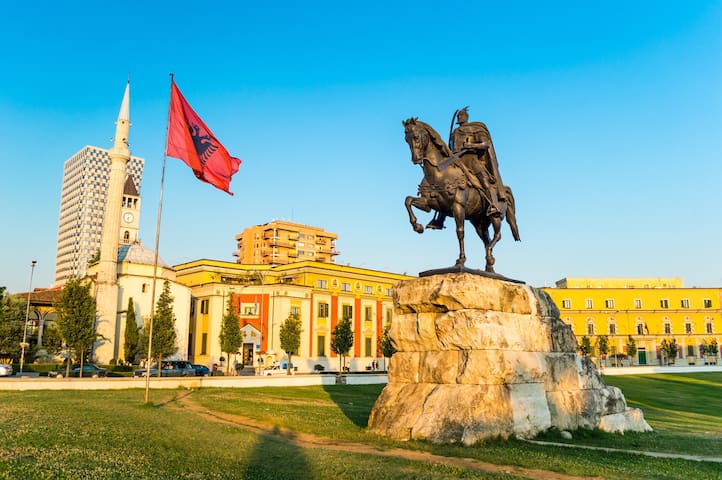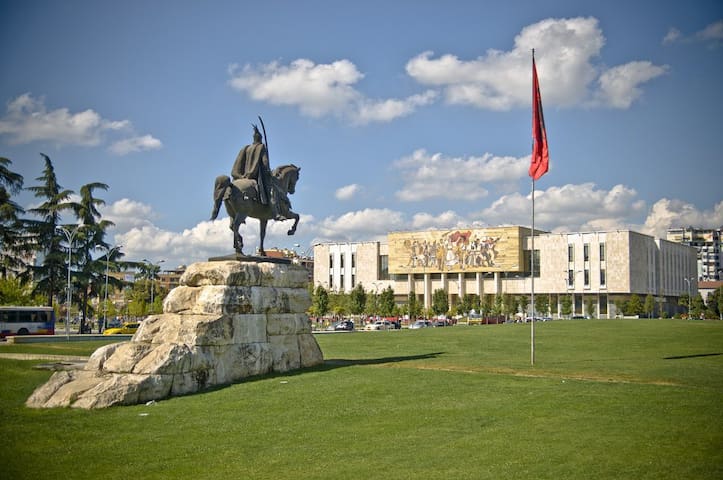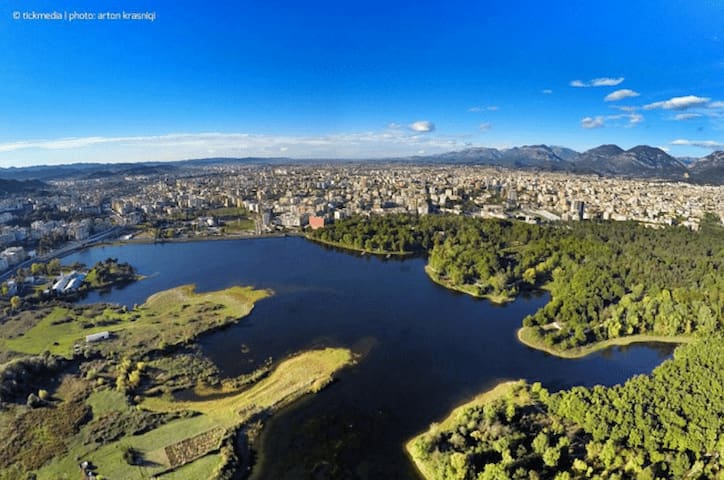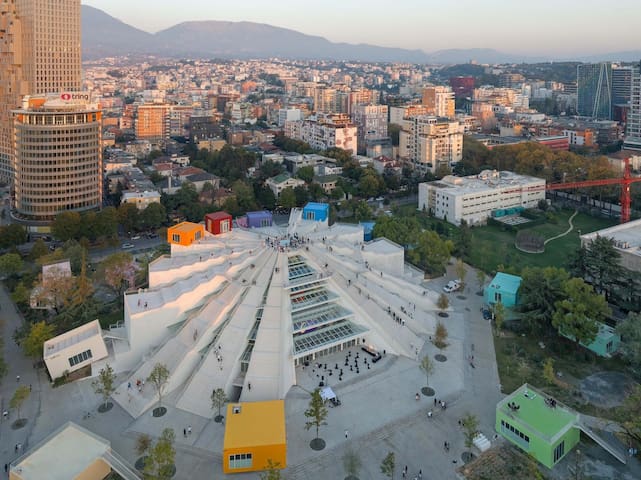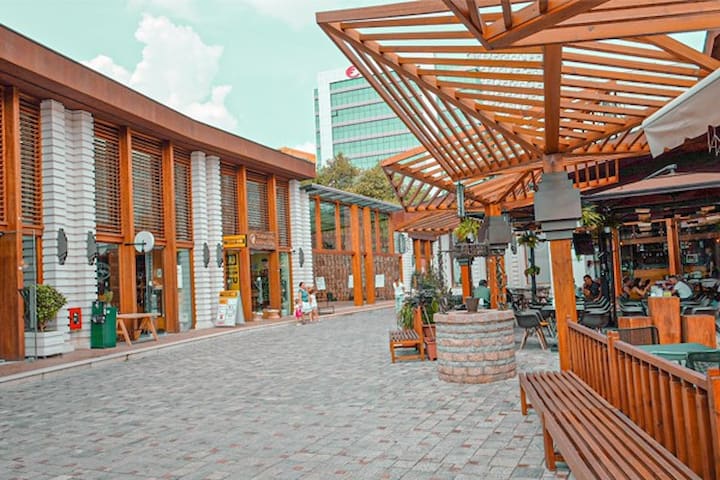Neighborhoods
Ish-Blloku (the former Block) known as Blloku is the most famous and expensive area in Tirana. It became very attractive after the fall of communism. During communism, the area was reserved solely for government officials and was not allowed to be entered by the commoner. It was opened to the public in 1991 and since then it became the number one spot for Tirana's youth. At night the area gets full of people especially on weekends when most night clubs are full. The streets, especially in summer afternoons, are filled with Tirana's citizens and expensive cars cruising around. You might not believe it but for the locals Blloku is more popular and more expensive than the city centre of Tirana.
There are many fancy Cafes, Restaurants, Lounges, Pubs and Night Clubs in the Blloku area. If you want to check out a fancy place in Tirana, then Blloku is the right place to go. However, what makes Blloku interesting to me is the variety among different styles.
132 当地人推荐
Blloku
Ish-Blloku (the former Block) known as Blloku is the most famous and expensive area in Tirana. It became very attractive after the fall of communism. During communism, the area was reserved solely for government officials and was not allowed to be entered by the commoner. It was opened to the public in 1991 and since then it became the number one spot for Tirana's youth. At night the area gets full of people especially on weekends when most night clubs are full. The streets, especially in summer afternoons, are filled with Tirana's citizens and expensive cars cruising around. You might not believe it but for the locals Blloku is more popular and more expensive than the city centre of Tirana.
There are many fancy Cafes, Restaurants, Lounges, Pubs and Night Clubs in the Blloku area. If you want to check out a fancy place in Tirana, then Blloku is the right place to go. However, what makes Blloku interesting to me is the variety among different styles.
The central square named after Albania's national hero, Gjergj Kastrioti Skanderbeg, with his statue as the centerpiece. Skanderbeg Square holds great historical importance for Albania. Named after the national hero, Gjergj Kastrioti Skanderbeg, who valiantly defended the country against the Ottoman Empire during the 15th century, the square serves as a commemoration of Albania's struggle for independence and national identity
Sheshi Skënderbej, Tiranë, 阿尔巴尼亚
The central square named after Albania's national hero, Gjergj Kastrioti Skanderbeg, with his statue as the centerpiece. Skanderbeg Square holds great historical importance for Albania. Named after the national hero, Gjergj Kastrioti Skanderbeg, who valiantly defended the country against the Ottoman Empire during the 15th century, the square serves as a commemoration of Albania's struggle for independence and national identity
Sightseeing
Bunk'art 2 reconstructs the history of the Albanian Ministry of Internal Affairs from 1912 to 1991 and reveals the secrets of “Sigurimi”, the political police that was the harsh persecution weapon used by the regime of Enver Hoxha. Bunk'art 2 is the first major video museum exhibition dedicated to the victims of communist terror.
195 当地人推荐
Bunk'Art 1
Rruga Fadil DeliuBunk'art 2 reconstructs the history of the Albanian Ministry of Internal Affairs from 1912 to 1991 and reveals the secrets of “Sigurimi”, the political police that was the harsh persecution weapon used by the regime of Enver Hoxha. Bunk'art 2 is the first major video museum exhibition dedicated to the victims of communist terror.
The largest museum in Albania holds many of the country's archaeological treasures and a replica of Skanderbeg's massive sword (how he held it, rode his horse and fought at the same time is a mystery). The lighting might be poor, but fortunately the excellent collection is almost entirely signed in English and takes you chronologically from ancient Illyria to the post-communist era. The collection of statues, mosaics and columns from ancient Greek and Roman times is breathtaking.
Hours 9am-7pm
Price 200 lekë/Person
A disturbing and very important gallery devoted to those who suffered persecution under the communist regime is the most recent addition to the collection, though frustratingly, almost none of this display is in English. Another highlight is a terrific exhibition of icons by Onufri, a renowned 16th-century Albanian master of colour. The modernist mosaic adorning the museum's facade is entitled Albania and shows Albanians victorious and proud from Illyrian times through to WWII, with some unsurprisingly communist overtones.
167 当地人推荐
国家历史博物馆
7 Sheshi SkënderbejThe largest museum in Albania holds many of the country's archaeological treasures and a replica of Skanderbeg's massive sword (how he held it, rode his horse and fought at the same time is a mystery). The lighting might be poor, but fortunately the excellent collection is almost entirely signed in English and takes you chronologically from ancient Illyria to the post-communist era. The collection of statues, mosaics and columns from ancient Greek and Roman times is breathtaking.
Hours 9am-7pm
Price 200 lekë/Person
A disturbing and very important gallery devoted to those who suffered persecution under the communist regime is the most recent addition to the collection, though frustratingly, almost none of this display is in English. Another highlight is a terrific exhibition of icons by Onufri, a renowned 16th-century Albanian master of colour. The modernist mosaic adorning the museum's facade is entitled Albania and shows Albanians victorious and proud from Illyrian times through to WWII, with some unsurprisingly communist overtones.
The Grand Park of Tirana (Albanian: Parku i Madh i Tiranës), or the Park on the Artificial Lake, is a 289 hectare public park situated on the southern part of Tirana, Albania.
The Park includes an artificial lake and many other landmarks such as the Saint Procopius Church, the Presidential Palace, and memorials to several Albanian personalities. It remains one of the most relaxing places in the city, despite increasing buildings being developed near the park, an early-morning run or promenade is a daily routines for many citizens. To the southern end of the Park, there is the Zoo and the Botanical Garden. The latter includes many flowers and plants that are common to the Albanian environment.
There are almost 120 species of trees, bushes and flowers. The Botanical Garden area is of 14.5 hectares and the lake's size is of 55 hectares, whereas the area of the Park itself is of 230 hectares.
The Park was built between 1955 and 1956 in a green area. The Park starts at the southern end of the Dëshmorët e Kombit Boulevard, after the University of Tirana, south of the main Skanderbeg Square. It was formerly called 'Park of Saint Procopius' (Albanian: Parku i Shën Prokopit) from the Saint Procopius Church, which is located in the area. In the internal parts, there can be found the memorials of 45 British and Australian soldiers fallen during World War II, as well as a memorial of hundreds of German soldiers from the same war.
59 当地人推荐
Grand Park of Tirana
Rruga Herman GmeinerThe Grand Park of Tirana (Albanian: Parku i Madh i Tiranës), or the Park on the Artificial Lake, is a 289 hectare public park situated on the southern part of Tirana, Albania.
The Park includes an artificial lake and many other landmarks such as the Saint Procopius Church, the Presidential Palace, and memorials to several Albanian personalities. It remains one of the most relaxing places in the city, despite increasing buildings being developed near the park, an early-morning run or promenade is a daily routines for many citizens. To the southern end of the Park, there is the Zoo and the Botanical Garden. The latter includes many flowers and plants that are common to the Albanian environment.
There are almost 120 species of trees, bushes and flowers. The Botanical Garden area is of 14.5 hectares and the lake's size is of 55 hectares, whereas the area of the Park itself is of 230 hectares.
The Park was built between 1955 and 1956 in a green area. The Park starts at the southern end of the Dëshmorët e Kombit Boulevard, after the University of Tirana, south of the main Skanderbeg Square. It was formerly called 'Park of Saint Procopius' (Albanian: Parku i Shën Prokopit) from the Saint Procopius Church, which is located in the area. In the internal parts, there can be found the memorials of 45 British and Australian soldiers fallen during World War II, as well as a memorial of hundreds of German soldiers from the same war.
MVRDV's design transforms the brutalist monument in the heart of the Municipality of Tirana, Albania’s capital city, once the showpiece of Communist dictator Enver Hoxha into an inclusive cultural hub. Reusing the concrete structure, the Pyramid is now home to a small village of colourful boxes, positioned both inside and outside the original building, that house cafés, studios, workshops, and classrooms where Albanian youth will learn various technology subjects for free
25 当地人推荐
地拉那金字塔
21 Rruga Dervish HimaMVRDV's design transforms the brutalist monument in the heart of the Municipality of Tirana, Albania’s capital city, once the showpiece of Communist dictator Enver Hoxha into an inclusive cultural hub. Reusing the concrete structure, the Pyramid is now home to a small village of colourful boxes, positioned both inside and outside the original building, that house cafés, studios, workshops, and classrooms where Albanian youth will learn various technology subjects for free
The Fortress of Justinian, known simply as Tirana Castle is the only one found in the city centre. The fortress is where at one time the main east–west and north–south roads crossed, forming the heart of the town as it was then. The castle history dates back prior to 1300. The walls are 6 m high and are a remnant from the Byzantine era. It is located near to Parliament and the Academy of Sciences, not far from Skanderbeg Square. The recently exposed wall foundations have been incorporated into the pedestrianized Murat Toptani Street.
The castle is open for visitors since December 2018.
The "Old Bazaar" of the castle is the newest jewel added in Tirana, a great space where modern and tradition meets together. This area serves as a culinary environment for traditional cooking, but also as an area of culture and art.
In this cultural and commercial space there are souvenir shops with a focus on Tirana's history, mosaics, traditional restaurants, etc.
49 当地人推荐
Kalaja e Tiranës
Shëtitorja Murat ToptaniThe Fortress of Justinian, known simply as Tirana Castle is the only one found in the city centre. The fortress is where at one time the main east–west and north–south roads crossed, forming the heart of the town as it was then. The castle history dates back prior to 1300. The walls are 6 m high and are a remnant from the Byzantine era. It is located near to Parliament and the Academy of Sciences, not far from Skanderbeg Square. The recently exposed wall foundations have been incorporated into the pedestrianized Murat Toptani Street.
The castle is open for visitors since December 2018.
The "Old Bazaar" of the castle is the newest jewel added in Tirana, a great space where modern and tradition meets together. This area serves as a culinary environment for traditional cooking, but also as an area of culture and art.
In this cultural and commercial space there are souvenir shops with a focus on Tirana's history, mosaics, traditional restaurants, etc.
The Tanners’ Bridge (Albanian: Ura e Tabakëve) is an 18th-century Ottoman period stone footbridge located in Tirana, Albania. The bridge, built near the Tanners’ Mosque, was once part of the Saint George Road that linked Tirana with the eastern highlands. The road was the rout by which livestock and produce entered the city. The bridge crossed the Lanë stream near the area where butcher shops and leather workers were located. The bridge fell into disrepair when the Lanë was diverted in the 1930s. In the 1990s the bridge was restored for use by pedestrians.
13 当地人推荐
Tanners' Bridge
Bulevardi "Jean D'ArcThe Tanners’ Bridge (Albanian: Ura e Tabakëve) is an 18th-century Ottoman period stone footbridge located in Tirana, Albania. The bridge, built near the Tanners’ Mosque, was once part of the Saint George Road that linked Tirana with the eastern highlands. The road was the rout by which livestock and produce entered the city. The bridge crossed the Lanë stream near the area where butcher shops and leather workers were located. The bridge fell into disrepair when the Lanë was diverted in the 1930s. In the 1990s the bridge was restored for use by pedestrians.
Et'hem Bey Mosque: An iconic Ottoman-era Mosque known for its stunning frescoes and intricate architectural details
47 当地人推荐
Et`hem Bey Mosque
Sheshi SkënderbejEt'hem Bey Mosque: An iconic Ottoman-era Mosque known for its stunning frescoes and intricate architectural details
Take a cable car ride to Mount Dajti for breathtaking views of Tirana and its surroundings.
Dajti Ekspres (Stacioni i poshtëm/Lower station)
Take a cable car ride to Mount Dajti for breathtaking views of Tirana and its surroundings.
A museum dedicated to the history of the Sigurimi, Albania's former secret police
52 当地人推荐
House of Leaves
A museum dedicated to the history of the Sigurimi, Albania's former secret police
Food scene
Located in a traditional Albanian house, Oda offers a cozy atmosphere and a menu featuring authentic Albanian dishes with a modern twist
31 当地人推荐
Oda - Traditional Albanian Cuisine
3 Rruga Luigj GurakuqiLocated in a traditional Albanian house, Oda offers a cozy atmosphere and a menu featuring authentic Albanian dishes with a modern twist
Renowned for its farm-to-table concept, Mullixhiu serves dishes made from locally sourced ingredients, highlighting the rich flavors of Albanian cuisine
47 当地人推荐
Mullixhiu
Renowned for its farm-to-table concept, Mullixhiu serves dishes made from locally sourced ingredients, highlighting the rich flavors of Albanian cuisine
A popular restaurant offering a diverse menu that includes Albanian and Mediterranean cuisine (Mainly Sea Food). Enjoy your meal in a stylish setting
Rozafa Sea Food
Rruga Luigj GurakuqiA popular restaurant offering a diverse menu that includes Albanian and Mediterranean cuisine (Mainly Sea Food). Enjoy your meal in a stylish setting

